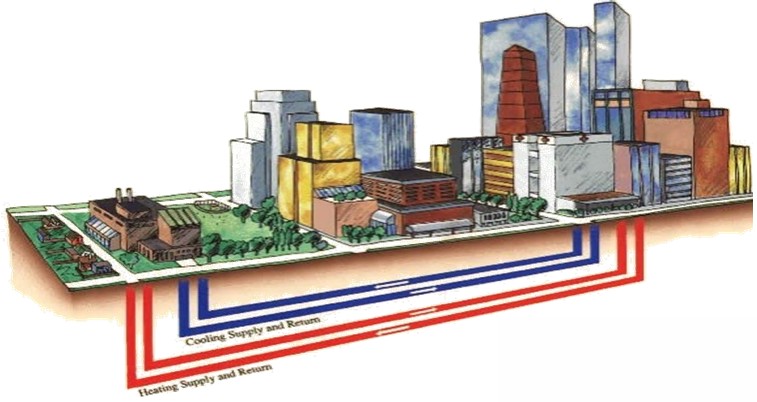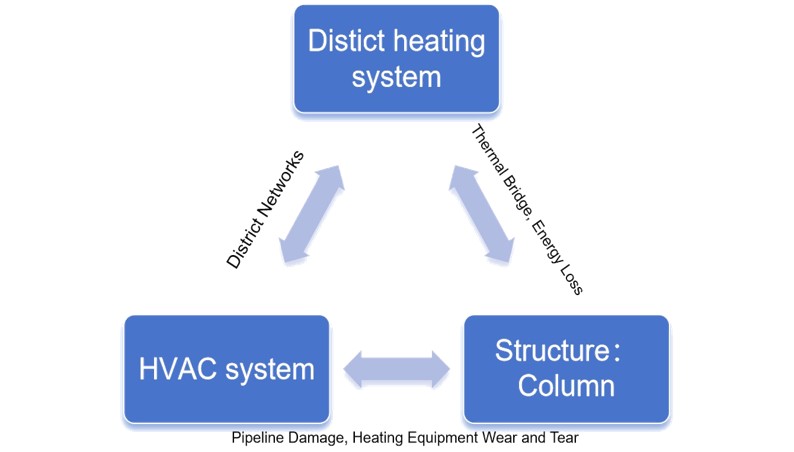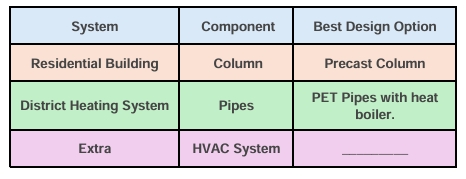Integration for Residential Buildings and District Heating Systems:
Residential buildings and district heating systems represent two essential components of modern infrastructure that significantly impact environmental sustainability and operational efficiency. Ensuring the reliability and longevity of these systems is critical to reducing energy consumption, minimizing environmental impacts, and improving occupant comfort. When integrating these systems, it is crucial to evaluate factors such as lifecycle deterioration, system interdependencies, and future maintenance requirements. A robust integration process must also consider sustainability metrics, risk assessments, and operational feasibility. This project aims to analyze the components of both systems and explore optimal integration and design options for enhanced performance and reduced environmental impact.


This project aims to analyze the components of both systems and explore optimal integration and design options for enhanced performance and reduced environmental impact.
Integration Context:
The integration context centers on a sustainable residential development heated by a district heating system. These residential buildings are equipped concrete building components such as Column and with efficient HVAC systems. The district heating system, in turn, supplies thermal energy to the buildings through a network of pre-insulated PET pipes connected to a centralized heat source. This heat source is designed to leverage renewable energy options like biomass or geothermal, reducing greenhouse gas emissions. A strong interdependency exists between these systems. The residential buildings rely on the district heating system for thermal comfort, while the heating system’s operational efficiency depends on consistent energy demand from the buildings.
Integration Challenges/ Interdependencies :
We face two primary challenges when integrating residential buildings and district heating systems:
- Interdependencies Between Systems:
- Residential buildings depend on district heating systems for thermal energy, making their maintenance schedules and performance deeply interconnected. For example:
- Any downtime in the heating system affects the livability of residential buildings.
- Variations in energy demand from buildings influence the operation and maintenance of the heating network.
- Structural deficiencies, such as damaged walls or structural components such as column, can lead to energy loss and higher heating requirements.
- Aligning the maintenance strategies for both systems to minimize interruptions and maximize efficiency is a critical challenge.
- Maintenance schedules for heating pipes must align with residential building repairs to minimize disruptions and energy losses
- Pipe failures can cascade into heating outages, directly affecting residential comfort.
- Residential buildings depend on district heating systems for thermal energy, making their maintenance schedules and performance deeply interconnected. For example:
- Design Optimization Across Systems:
- We must optimize multiple conflicting objectives, such as:
- Reducing energy consumption and environmental impacts (e.g., CO2, NOx, SO2 emissions).
- Minimizing operational and maintenance costs for both buildings and the heating system.
- Ensuring reliability and availability of heating services.
- This requires defining performance criteria for both systems and using multi-objective optimization techniques to balance environmental, economic, and operational goals.
- We must optimize multiple conflicting objectives, such as:
These challenges demand an integrated approach to lifecycle assessment and maintenance planning, ensuring that both systems perform optimally while minimizing disruptions and environmental impacts.
Key Note :
A district heating system is not inherently a subsystem of an HVAC system, To make our model more holistic district system can be integrated with HVAC systems to provide heating as a part of building climate control.
Integration:
- In buildings connected to a district heating system, the district heating acts as a heat source for the HVAC system. The HVAC system manages the internal distribution of heat, ventilation, and additional climate control functions like cooling and air circulation. We model the district heating system as the external heat supply for residential buildings, integrating it into the HVAC’s heat management process.
| Main Page | Introduction | Individual Systems | Integration Context | Integrated Maintenance Strategies | Life Cycle Analysis | Multi-Objective Optimization |
